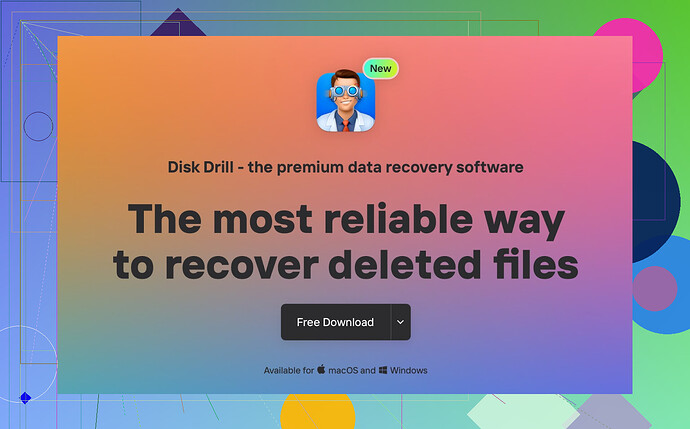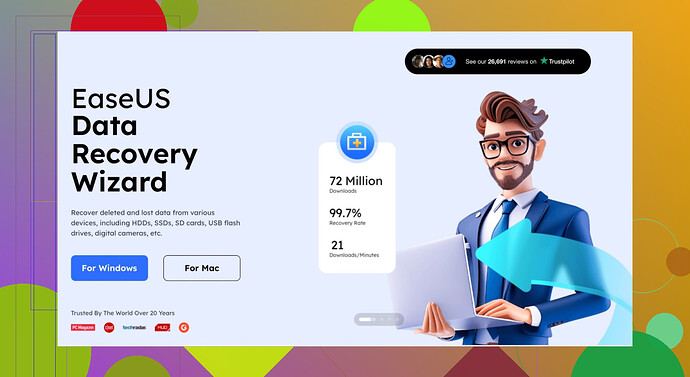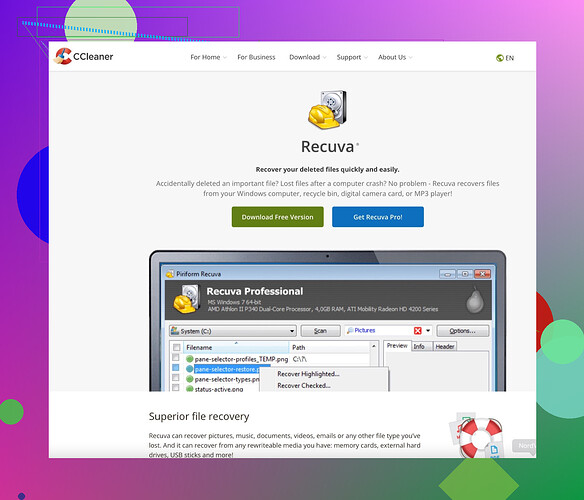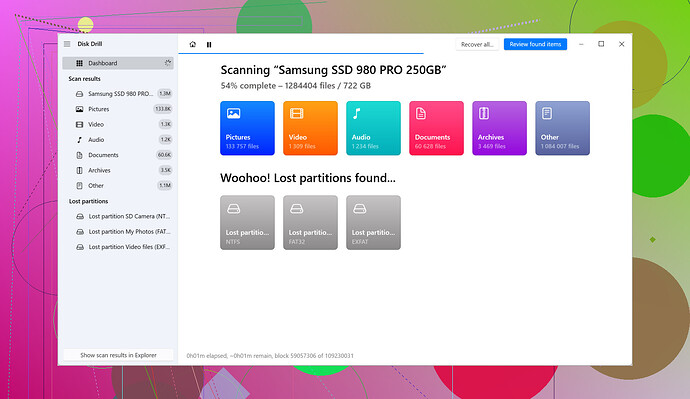Lost important files on my Windows computer and urgently need a reliable solution to recover them. Can anyone recommend the best data recovery software that actually works?
Top Data Recovery Software for Mac & Windows: Both Free and Paid Options
Losing important files can be a nightmare, whether it happens due to accidental deletion, formatting errors, or unforeseen system crashes. Fortunately, there’s a wide range of tools designed to assist you in retrieving those lost files. Here’s a breakdown of the best data recovery software available for both Mac and Windows users, highlighting their key features, limitations, and suitability for different needs.
1. Disk Drill (Mac & Windows)
Disk Drill is often celebrated for its ease of use and versatility, making it ideal for both beginners and experts in data recovery.
Pros:
 Intuitive, beginner-friendly interface.
Intuitive, beginner-friendly interface. Supports recovery for over 400 file types across various storage formats.
Supports recovery for over 400 file types across various storage formats. Comes with extra utilities like Recovery Vault for future data protection.
Comes with extra utilities like Recovery Vault for future data protection. Windows users can recover up to 500MB for free.
Windows users can recover up to 500MB for free.
Cons:
- ✘ Limited functionality in the free version on Mac (can only preview files).
- ✘ Deep scans may take longer to complete.
- ✘ Full recovery capabilities require purchasing a license.
Verdict:
A robust and simple recovery solution with room for both experimentation and professional work. The free trial is great for lightweight tasks, and the premium version expands its versatility.
Useful Links:
- Disk Drill Homepage
- Disk Drill Review on Reddit
- Watch on YouTube: https://www.youtube.com/watch?v=IGEizr1WZ3E
2. EaseUS Data Recovery Wizard (Mac & Windows)
EaseUS stands out for its simplicity and AI-driven features, making recovery seamless for everyday users.
Pros:
 Features a straightforward three-step recovery process.
Features a straightforward three-step recovery process. AI-powered scanning enhances deep file recovery.
AI-powered scanning enhances deep file recovery. Free tier allows up to 2GB of data recovery.
Free tier allows up to 2GB of data recovery. Handles lost partition and RAW recovery efficiently.
Handles lost partition and RAW recovery efficiently.
Cons:
- ✘ The free version’s 2GB limit may be insufficient for recovering large files.
- ✘ Extended scans can take significant time to finish.
- ✘ Requires a paid plan to unlock full recovery capabilities.
Verdict:
EaseUS is an intuitive and powerful choice for general recovery tasks, ensuring high reliability for routine file retrieval.
Useful Links:
3. Recuva (Windows Only)
If you’re looking for a free solution that’s fast and light on system resources, Recuva is an excellent pick for Windows users.
Pros:
 Completely free with unlimited file recovery.
Completely free with unlimited file recovery. Lightweight software that runs quickly.
Lightweight software that runs quickly. Comes with a portable version.
Comes with a portable version.
Cons:
- ✘ Not available for macOS users.
- ✘ Lacks more advanced data recovery features.
- ✘ May struggle with recovering heavily damaged files.
Verdict:
A solid, no-cost choice for basic recovery tasks, perfect for users needing an uncomplicated tool to retrieve lost files on Windows.
Useful Links:
4. Stellar Data Recovery (Mac & Windows)
Stellar is known for its robust recovery capabilities, particularly for multimedia files like videos and photos.
Pros:
 Advanced recovery for photos, emails, and videos.
Advanced recovery for photos, emails, and videos. Compatible with a variety of storage devices.
Compatible with a variety of storage devices. Free version allows recovery of up to 1GB of files.
Free version allows recovery of up to 1GB of files. High success rate for recovering lost data.
High success rate for recovering lost data.
Cons:
- ✘ The 1GB limit on the free version can be restrictive.
- ✘ Slow scanning process.
- ✘ Advanced features require higher-tier licenses.
Verdict:
An excellent all-around performer, Stellar is especially useful for those prioritizing recovery of multimedia content.
5. TestDisk & PhotoRec (Mac & Windows, Open-Source)
For tech-savvy users, this free and highly capable open-source tool is a fantastic resource.
Pros:
 Completely free to use, with no hidden charges.
Completely free to use, with no hidden charges. Excels at deep scanning and partition recovery.
Excels at deep scanning and partition recovery. Works across multiple operating systems.
Works across multiple operating systems.
Cons:
- ✘ Operates via a command-line interface, making it challenging for beginners.
- ✘ Lacks user-friendly graphical tools.
Verdict:
A go-to solution for advanced users who need extensive recovery capabilities without spending a dime.
6. R-Studio (Mac & Windows)
R-Studio is a professional-grade tool, delivering unmatched precision and advanced functionality.
Pros:
 Highly capable in handling complex tasks like RAID recovery.
Highly capable in handling complex tasks like RAID recovery. Broad compatibility with various file systems and devices.
Broad compatibility with various file systems and devices. Ideal for network recovery scenarios.
Ideal for network recovery scenarios.
Cons:
- ✘ Steep learning curve with a less intuitive interface.
- ✘ Paid-only offering, with no meaningful free version.
Verdict:
Best suited for IT professionals and businesses dealing with large-scale or intricate data recovery projects.
7. Wondershare Recoverit (Mac & Windows)
Wondershare is particularly noted for its user-focused design and additional video recovery options.
Pros:
 Easy-to-navigate interface.
Easy-to-navigate interface. Supports over 1,000 file formats.
Supports over 1,000 file formats. Special tools for recovering and repairing videos.
Special tools for recovering and repairing videos.
Cons:
- ✘ Free version is limited to 500MB of data recovery.
- ✘ Detailed, deep scans can be time-consuming.
Verdict:
An ideal pick for beginners and creatives who work with video content.
8. Ontrack EasyRecovery (Mac & Windows)
Preferred by professionals, Ontrack delivers premium features tailored for critical recovery scenarios.
Pros:
 Widely trusted by experts in data recovery.
Widely trusted by experts in data recovery. Includes RAID and email recovery in premium tiers.
Includes RAID and email recovery in premium tiers. Free version permits 1GB of recovery.
Free version permits 1GB of recovery.
Cons:
- ✘ Free tier limits file size to 25MB.
- ✘ Premium licenses can be expensive.
Verdict:
A dependable choice for enterprises and professionals tackling high-stakes data recovery jobs.
9. Prosoft Data Rescue (Mac & Windows)
Focused heavily on providing support for Mac users, Prosoft is outstanding at retrieving data from damaged drives.
Pros:
 Comprehensive recovery features.
Comprehensive recovery features. Includes drive cloning for working with compromised hardware.
Includes drive cloning for working with compromised hardware. Well-optimized for macOS environments.
Well-optimized for macOS environments.
Cons:
- ✘ Pricing can be confusing, with pay-per-recovery options.
- ✘ Lacks lifelong license options.
Verdict:
Perfect for macOS users who require powerful yet focused retrieval tools.
10. MiniTool Power Data Recovery (Windows Only)
MiniTool caters to Windows users with a straightforward and efficient data recovery process.
Pros:
 Simple, no-frills interface.
Simple, no-frills interface. 1GB of free data recovery included.
1GB of free data recovery included. Great for minor recovery tasks.
Great for minor recovery tasks.
Cons:
- ✘ Exclusively for Windows.
- ✘ Doesn’t handle advanced cases as effectively.
Verdict:
A dependable free solution for hassle-free recovery of smaller data loss scenarios on Windows.
Final Thoughts
Here’s a recap of the best tools for different recovery needs:
- For Beginners: Disk Drill, EaseUS Data Recovery Wizard, and Recoverit.
- For Free Options: Recuva (Windows) and TestDisk (Mac & Windows).
- For Professionals: R-Studio, Disk Drill, and Ontrack EasyRecovery.
- For Video Recovery: Wondershare Recoverit and Disk Drill.
If your data loss is minimal, start with one of the free tools. For more complex cases, consider investing in a premium option to ensure higher success rates.
Honestly, if you’ve lost important files on Windows, go straight for Disk Drill. It’s a solid all-rounder and incredibly easy to use, especially if you’re not a tech wizard. From personal experience, it saved me when I accidentally wiped an entire folder of work files (pro tip: don’t over-rely on Ctrl+Z). Disk Drill supports over 400 file types and the free version lets you recover up to 500MB, which is perfect for testing before committing to the paid version.
That said, if you’re dealing with something more advanced, like recovering from a formatted disk or heavily damaged files, you might want to look at more professional tools like R-Studio (but be warned—it’s got the UI of an early 2000s relic). For a truly free option, there’s always Recuva, but don’t expect miracles. It’s lightweight and works for surface-level recovery, but it might choke on anything beyond simple deletions.
Avoid software that promises the world in their ads but delivers half-baked results. Recoverit and Stellar are decent, but IMO, they’re overpriced for what they offer. Keep expectations realistic—nothing is guaranteed with data recovery! Oh, and a little tip: stop using the drive ASAP to avoid overwriting files. Fingers crossed!
From my experience and a bit of digging around, if you’re dealing with lost files on Windows, Disk Drill is definitely up there. It’s got an easy interface, supports over 400 file types, and the free version lets you recover up to 500MB, which isn’t bad if you want to test it out. It’s not overly complicated, so even if you’re not super tech-savvy, it’s manageable. But yeah, the real power is in the paid version.
Now, there’s a lot of hype about EaseUS, and sure, it’s user-friendly and all, but the free version only gives you 2GB of recovery, and for anything substantial, you’ll need to upgrade. Still, worth a shot if you’re into that AI-driven scan thing. Also, don’t skip over Recuva, especially if your budget = $0. It’s free and does basic file recovery really well, but it’s not as great for more complex jobs like formatted drives or partition loss.
Honestly, unless you’re tackling super advanced issues like RAID recovery, you probably won’t need hardcore tools like R-Studio (also, good luck figuring out its 2005-era UI). Others like Stellar Data Recovery or Recoverit are okay, but in my opinion, they feel overpriced for what they offer. If you’re running low on time, just get Disk Drill, avoid running any more processes on the affected drive, and pray Windows hasn’t messed things up too much.
Keep in mind: no recovery software = guaranteed results. Best-case scenario: you get your files back. Worst-case? You’ve learned to never skip backups again.



